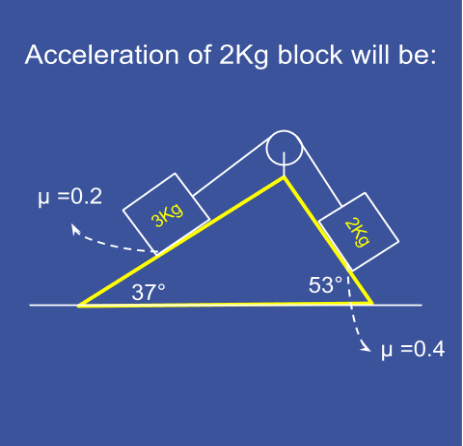What is the Acceleration?

Find the acceleration of the \(2\text{ kg}\) block in \(\text{ms}^{-2}\) ?
Source: This beautiful question appeared at eagerbug.com . I hope everyone like solving it.! :)
No vote yet
1 vote
Easy Math Editor
This discussion board is a place to discuss our Daily Challenges and the math and science related to those challenges. Explanations are more than just a solution — they should explain the steps and thinking strategies that you used to obtain the solution. Comments should further the discussion of math and science.
When posting on Brilliant:
*italics*or_italics_**bold**or__bold__paragraph 1
paragraph 2
[example link](https://brilliant.org)> This is a quote# I indented these lines # 4 spaces, and now they show # up as a code block. print "hello world"\(...\)or\[...\]to ensure proper formatting.2 \times 32^{34}a_{i-1}\frac{2}{3}\sqrt{2}\sum_{i=1}^3\sin \theta\boxed{123}Comments
Let me revise frictional force topic again has been two years since I last learned it ;)
Log in to reply
As you say my friend:-)
If those are static friction coefficients, then a=0 is possible.
If these are kinetic friction coefficients, write the force balance for each block. I'm assuming the wedge is massless.
The centre of mass will move downwards only, so acceleration of the heavier block will be down the plane, and the lighter one will move up the plane. As the string does not extend/contract, these accelerations are same in magnitude.
Can you solve it from here?
Log in to reply
Right sir, thank you.!
Log in to reply
I guess Ameya already answered it. ;)
Log in to reply
Does that mean you won't post a solution? Please do! I need to understand it completely!
Taking the 3kg block accelerating downwards T−μmgcosθ−mgsinθ=ma(1)Mgsinα−μ′Mgcosα=Ma(2)Adding1and2weget(Msinα−msinθ)g−g(μ′Mcosα+μmcosθ)=(M+m)a⇒18−16−4.8−4.8=5a⇒a=−57.2.2=−1.52ms−2 - sign means that the acceleration of the system is in opposite direction to that I have assumed here, i.e. 2kg block slides downward. However taking the other block(i.e. 2kg) accelerating downwards, −18+16−4.8−4.8=5a⇒a=−511.6=−2.32ms−2 As these results are contradictory, I think that the system wont accelerate. So a=0
Log in to reply
Please retry and calculate and see if your answer matches with the options I have provided.
@Swapnil Das ; a good problem for you & for the physics section, I hope ! :-)
@Ashish Siva, @Deeparaj Bhat , @Abhay Tiwari , please comment!
Log in to reply
Sorry Rishabh, I am not good at this topic.
Log in to reply
Not a problem bro, Ur Perfect! Me2 not good at this.
Log in to reply
I am not sure but I guess the 3kg will pull with a Force of F=g[(3 Sin(37°)−0.2×3× Cos(37°)) − (2 Sin(53°)−0.4×2× Cos(53°))]=2.1481 kg ms−2, if g=10 ms°−2
Log in to reply
I think the second half of the force is not needed, first half would be the force driving the 3kg block down & you also have to subtract tension from that!
Log in to reply
Ha ha. Let me see if somebody posts a solution. Maybe then I will understand.
Log in to reply
Ya right, I expect a good solution from @Swapnil Das or @Deeparaj Bhat , however, anyone is free to post a solution! :-)
Hey does anyone know the answer? I got 1.52m/s2
Log in to reply
Also according to my solution the 2 kg block moves up the slope @Rishabh Tiwari Do you know the correct answer ?
I don't know the answer but here are the options:
(a) 2 (b) 0
(c) 2.32 (d) 1.8